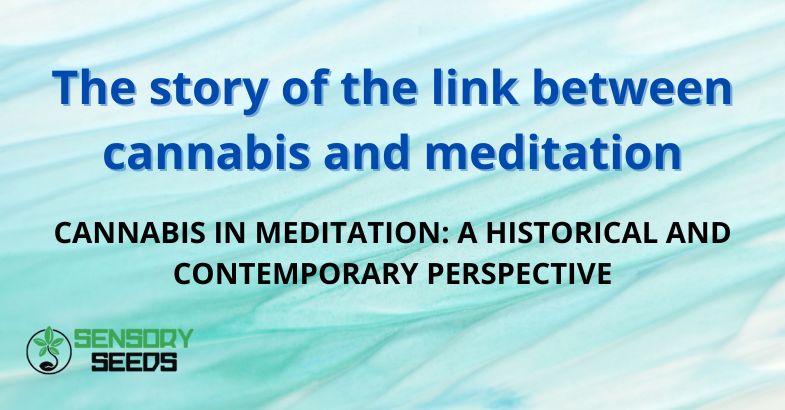Published on: 20/10/2023
CANNABIS IN MEDITATION: A HISTORICAL AND CONTEMPORARY PERSPECTIVE
In the exploration of meditative practices, one fascinating element has gained attention in recent years: the use of cannabis as a tool to deepen the meditation experience.
This ancient and versatile plant has accompanied humanity for millennia in various fields, including the spiritual one. But how can cannabis affect our meditation practice and on what historical and religious foundations is this connection based?
In the following article we will explore the millennial history of meditation and the use of cannabis in this practice, crossing cultures and traditions that attributed a sacred and transcendental role to this plant. We will also explore what the real effects of the latter are, trying to understand if it can really be a means to facilitate meditation itself.
Meditation: the key to a life full of awareness and authenticity
Meditation is an ancient and widespread practice in many cultures that aims to bring the mind to a state of calm, concentration and awareness. Meditating means observing the present with non-judgmental attention, letting go of the thoughts and emotions that distract us and create stress. Getting in touch with our body, our sensations and our breath, recognizing our deep nature and our connection with everything.
There are many benefits to meditation, both physically and psychologically. This practice helps reduce blood pressure, heart rate, cortisol level and other stress hormones, promotes muscle relaxation, sleep, immune system and wound healing.
And the benefits aren’t limited to these.
Meditation, in fact, improves memory, attention, creativity, problem solving and mood, while enhancing self-esteem, empathy, compassion and happiness.
It doesn’t take much to start meditating: just find a quiet and comfortable place, choose a position that allows us to stand upright but relaxed, close our eyes or stare at a point in front of us and dedicate at least 10 minutes a day to practice. There are different methods and techniques, but the simplest and most universal is to focus attention on the breath, following the flow of air that enters and leaves the nostrils. Whenever we realize we are distracted by a thought or a noise, we must gently bring our attention back to our breathing, without judging or getting angry.
Meditation requires perseverance and patience, but the results are amazing. With regular practice you can reach a state of inner peace, mental clarity and harmony with yourself and with others.
Meditation is a way to discover our true potential and to live a fuller and more meaningful life.


Natural elements for deep meditation
There are several elements present in nature that, according to those who practice meditation, can help facilitate it, both for beginners and for the more experienced.
Among the most used natural substances we find:
incense, an aromatic resin that is burned to produce a pleasant and relaxing scent. There are different types, including sandalwood, myrrh, benzoin and copal which can be useful for creating a calm and sacred atmosphere, favoring concentration and meditation;
various types of herbs possess beneficial properties for health and well-being. Among those that can be used for meditation, both in the form of infusions and essential oils, we should mention chamomile, lavender, rosemary and sage;
different varieties of flowers are able to exert positive effects on mood and emotions and are useful for meditation both in the form of decorations and as flower essences. Some typical examples used in this context are lotus, jasmine, cherry blossom and orange blossom.
In addition to the natural substances mentioned above, those who practice meditation can also promote relaxation with the help of objects possessing particular properties, such as:
crystal bells: they are musical instruments that produce a harmonious and relaxing sound and can help improve concentration and achieve a state of tranquility. Crystal bowls can be struck traditionally or using a mallet;
candles: these can be chosen in different colors and scents, depending on personal preferences, and help create a welcoming and intimate environment, encouraging meditation;
stones, minerals or rocks with certain physical or energetic properties. Some of these can be used for meditation, both as ornaments and as talismans, such as amethyst, quartz, tiger’s eye and agate.
In essence, there are different substances and materials that can help you quickly achieve the inner peace necessary to meditate successfully, but their effectiveness depends on each person’s needs and inclinations. Therefore, it is important to keep in mind that meditation is a personal practice, that what works for one person may not work for another, and that it is advisable to experiment with different solutions to find the one that best suits your style.
Cannabis as a bridge between the human and the divine: a historical and religious perspective
Cannabis is an ancient and versatile plant, which has accompanied humanity for millennia in various fields: textile, medicinal, recreational and spiritual.
It is native to Central Asia, where it was cultivated and used since the Neolithic and the first written reference to the plant and its therapeutic use is found in a Chinese pharmacology treatise dated to 2737 BC, attributed to Emperor Shen Nung. Based on our current knowledge, we know that the Chinese used it both as a fiber and as a remedy for various ailments, including rheumatic and menstrual pains.
But cannabis was not only a useful plant, it was also a sacred plant. In Indian Vedic culture, for example, it was the main ingredient of soma, a ritual drink that induced a state of ecstasy and connection with the divine and the Hindus consumed bhang, another cannabis-based infusion, typical of parties and ceremonies like the holi festival. In general, many Indian religious subcultures believed that the plant’s psychoactive properties were central to meditation and other spiritual practices.
Cannabis also spread to other regions of Asia and the Middle East, where it was used by peoples such as the Scythians and Persians. The former, for example, used to vaporize it in tents heated by braziers and inhale its fumes until they reached a state of trance. The Persians, however, followers of Zoroaster, used cannabis to access prophetic visions and communicate with spirits.
This plant also arrived in Europe around 500 BC, where it was cultivated and used for both textiles and recreation. The first prohibition against cannabis occurred in 1484 with a papal bull which prohibited its use by the faithful. However, it continued to be appreciated by many intellectuals and artists, such as members of the famous Club des Hashischins in Paris, which brought together writers of the caliber of Victor Hugo, Alexandre Dumas, Charles Baudelaire and others.
Another religious movement that has made cannabis a central element is Rastafarianism, which originated in Africa in the 20th century. Rastafarians revere the Ethiopian emperor Haile Selassie I as an incarnation of God and consider marijuana as a sacred and beneficial plant: the Tree of Life mentioned in the Bible. For this reason they usually use cannabis to meditate, pray and celebrate their ceremonies, believing it brings them closer to the divine and truth.
As you can see, the history of using cannabis in meditation is long and varied, testifying to the allure and power of this millennial plant. From a vast number of cultures and religions, even in very recent times, marijuana has been considered as an entheogen, or a substance that generates the divine within itself, facilitating the expansion of consciousness and the connection with the whole.
The use of cannabis as a tool for meditation and trance
Cannabis is a plant that contains several chemicals called cannabinoids, including THC and CBD, compounds that can interact with our body’s endocannabinoid system, a set of neurological receptors that regulate various physiological processes such as mood, pain , appetite and sleep.
As we have seen above, based on the beliefs of certain cultures and religions, the properties of this plant would seem able to help the practice of meditation and this belief is quite widespread even today.
Many people, in fact, claim that cannabis helps them relax and free themselves from negative thoughts so as to facilitate the achievement of a trance state (typical of meditation) and to connect with one’s self and with the surrounding nature. Others also claim that meditation itself feeds back positively with marijuana, helping them manage psychoactive effects, avoid paranoia and anxieties, heighten bodily sensations, and safely experience altered states of consciousness.
The risks of taking cannabis: from memory to coordination
Despite everything that has been said so far, we must not forget that cannabis in the UK is subject to strict legislation which prohibits its production (even for personal use only) and consumption. Therefore its meditative potential cannot be exploited in our country without committing an offence.
In addition, even in the presence of permissive legislation that allows its consumption, the possible negative effects associated with the intake of this substance must always be kept in mind, among which we mention:
impaired sensory perception, time and space;
decreased memory, concentration, and cognitive abilities;
excessive euphoria, or anxiety, depending on the context and type of cannabis;
increased appetite and thirst;
dry mouth and eyes;
tachycardia, hypotension and vasodilatation;
impaired motor coordination and reflexes;
drowsiness or insomnia;
psychophysical dependence on THC.
Read also: An overview of the close relationship between cannabis and music
In conclusion
The practice of meditation offers numerous benefits for our physical and mental well-being. It allows us to reach a state of inner calm, awareness and authenticity, leading us to a fuller and more meaningful life. Meditation improves our physical health by reducing blood pressure, cortisol level, and promoting muscle relaxation and the immune system. Furthermore, it enhances our cognitive abilities, memory, attention, creativity and mood, improving self-esteem, empathy and compassion.
It is essential to remember that taking cannabis for meditation involves risks and that the legislation on the matter varies from country to country. In the UK, for example, the use of cannabis is prohibited, and even in the presence of permissive legislation it is important to consider the negative effects associated with the intake of this substance. Therefore, it is always a must to practice meditation safely and comply with the applicable law.
We hope that the article has satisfied your curiosity and, before concluding, we have a surprise to share with you. If you’re here, chances are you’re passionate about all things cannabis, right? So why not feed your passion with a selection of high quality marijuana seeds?
We invite you to take a look at the products available in our Sensoryseeds shop.
You will find a wide choice: fast flowering seeds, feminized seeds and autoflowering seeds of different varieties, ready to enrich your collection!


TAKEAWAYS ON MEDITATION AND CANNABIS
Cannabis is an ancient plant that has been used for millennia in a variety of contexts, including textile, medicinal, recreational and spiritual.
Different cultures and religions have considered cannabis as a sacred plant and have used it in ritual practices to achieve states of ecstasy, connection with the divine and prophetic visions.
This spiritual use of cannabis can be found in different cultures, such as the Vedic culture of India, among the Scythians and Persians, as well as in more recent religious movements such as Rastafarianism.
Cannabis has been seen as a means to expand consciousness, facilitate meditation, access trance states, and connect with one’s inner self and with the surrounding nature.
Cannabis contains cannabinoids, such as THC and CBD, which can interact with the endocannabinoid system of the human body, influencing various physiological processes, including mood and sensory perception.
Some people claim that using cannabis helps them relax and free themselves from negative thoughts, easing the trance state during meditation and allowing for greater connection with themselves and their surroundings.
Others argue that meditation may interact positively with the psychoactive effect of cannabis, helping manage the effects, heightening bodily sensations, and enabling experiences of altered consciousness in a safe way.
It is important to remember that cannabis is subject to strict regulations in many countries, including the UK, where its production and consumption are prohibited.
Regardless of the legality, it is essential to consider the possible negative effects of cannabis use, such as the impairment of sensory perception, memory, concentration and cognitive abilities.
Other undesirable effects may include euphoria and anxiety depending on the context and type of cannabis, increased appetite, dry mouth, tachycardia, impaired motor and reflex coordination, drowsiness or insomnia and potential psychophysical dependence on THC.
CANNABIS AND MEDITATION FAQ
What is meditation and what is its purpose?
Meditation is an ancient and widespread practice in many cultures that aims to bring the mind to a state of calm, concentration and awareness. Its purpose is to observe the present with a non-judgmental attention, letting go of the thoughts and emotions that cause stress, and connect with your body, sensations and breath, recognizing your deepest nature and connection with the whole.
What are the benefits of meditation?
Meditation offers numerous benefits both physically and psychologically. Among the physical benefits, there are reductions in blood pressure, heart rate and cortisol levels, as well as improved sleep, the immune system and wound healing. On a psychological level, meditation improves memory, attention, creativity, problem solving, mood, self-esteem, empathy, compassion, and happiness.
Can cannabis be used as a support for meditation practice?
Cannabis may be considered by some people as an aid to meditation practice. Some argue that the use of cannabis can promote relaxation and release from negative thoughts, thus facilitating the achievement of a meditative trance state and greater connection with oneself and with the surrounding environment. However, it is important to note that the effect of cannabis can vary from person to person and that the use of this substance during meditation can have negative effects on memory, concentration and cognitive abilities.









